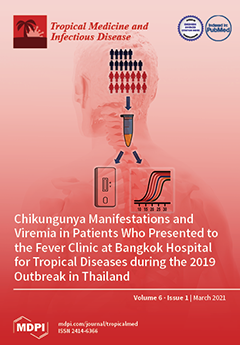Open AccessCase Report
SARS-CoV-2 Infection and CMV Dissemination in Transplant Recipients as a Treatment for Chagas Cardiomyopathy: A Case Report
by
Sarah Cristina Gozzi-Silva, Gil Benard, Ricardo Wesley Alberca, Tatiana Mina Yendo, Franciane Mouradian Emidio Teixeira, Luana de Mendonça Oliveira, Danielle Rosa Beserra, Anna Julia Pietrobon, Emily Araujo de Oliveira, Anna Cláudia Calvielli Castelo Branco, Milena Mary de Souza Andrade, Iara Grigoletto Fernandes, Nátalli Zanete Pereira, Yasmim Álefe Leuzzi Ramos, Julia Cataldo Lima, Bruna Provenci, Sandrigo Mangini, Alberto José da Silva Duarte and Maria Notomi Sato
Cited by 13 | Viewed by 4122
Abstract
Coronavirus disease 2019 (COVID-19) is caused by severe acute respiratory syndrome coronavirus 2 (SARS-CoV-2). COVID-19 has infected over 90 million people worldwide, therefore it is considered a pandemic. SARS-CoV-2 infection can lead to severe pneumonia, acute respiratory distress syndrome (ARDS), septic shock, and/or
[...] Read more.
Coronavirus disease 2019 (COVID-19) is caused by severe acute respiratory syndrome coronavirus 2 (SARS-CoV-2). COVID-19 has infected over 90 million people worldwide, therefore it is considered a pandemic. SARS-CoV-2 infection can lead to severe pneumonia, acute respiratory distress syndrome (ARDS), septic shock, and/or organ failure. Individuals receiving a heart transplantation (HT) may be at higher risk of adverse outcomes attributable to COVID-19 due to immunosuppressives, as well as concomitant infections that may also influence the prognoses. Herein, we describe the first report of two cases of HT recipients with concomitant infections by SARS-CoV-2,
Trypanosoma cruzi, and cytomegalovirus (CMV) dissemination, from the first day of hospitalization due to COVID-19 in the intensive care unit (ICU) until the death of the patients.
Full article
►▼
Show Figures






